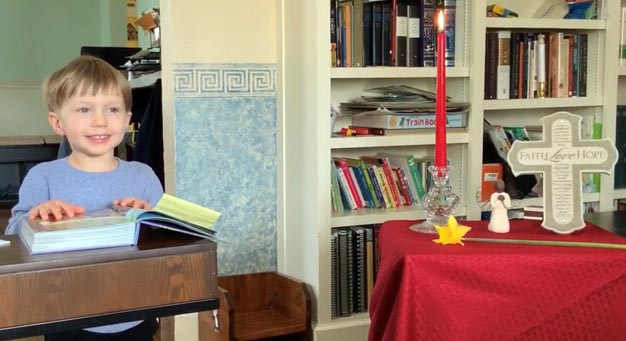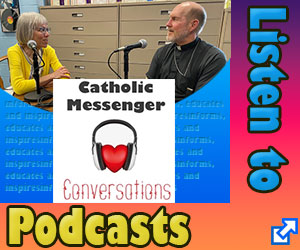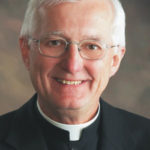
Matthew Schmadeke at home on Palm Sunday.
By Patrick Schmadeke
“This is the day the Lord has made; let us rejoice and be glad,” we kept repeating to ourselves as we picked up the mess of Cheerios on the floor. Discovering beauty in what would be an otherwise annoying moment is one of the more memorable experiences since the start of our regular COVID-19 in-home liturgies.
Rachel and I found ourselves somewhat unsatisfied, and our 3-year-old mostly unstill, when we tried watching Mass online during the first week of the COVID-19 lockdown back in mid-March. So, we started designing and celebrating a Liturgy of the Word service in our home every weekend, as all baptized persons can do.
We follow the Scripture readings for Mass for the day including the responsorial psalm, sing an opening and closing song which Rachel often accompanies by playing the flute. I offer a reflection on the readings, and our 3-year-old has the task of throwing us curve balls along the way. The in-home liturgies haven’t been all sunshine and rainbows, but they have facilitated some profound experiences for our family and an opportunity to be intentional about liturgy in a new way.
The “Cheerios event” mentioned above, for example, was in the middle of our Easter Sunday liturgy. Our 3-year-old Matthew was a little tired at the moment and was moving about a little recklessly before we started our service. My gut said he was going to spill the Cheerios, but he was in no mood to have them taken from him, so we rolled with it. It didn’t take long, and in the middle of the responsorial psalm, down went the Cheerios. As we all moved to pick up the mess, Rachel began repeating melodically, “this is the day the Lord has made; let us rejoice and be glad.” I joined in after the first repetition, and eventually Matthew joined in, too. The irony of the moment was hard to miss — picking up spilled Cheerios while reciting a psalm of praise transformed an otherwise frustrating experience of interruption into a moment of patience and bonding. Liturgy transformed our experience.
Such spontaneity has been a hallmark of these liturgies. We have a structure to follow, but we inevitably get off-track along the way. Like the “Cheerios event,” often times this is actually for the better. For example, after I offered a reflection on Palm Sunday, Matthew decided he would do the same. He stood proudly at our makeshift lectern, opened up his children’s Bible, and started telling us about Jesus. He turned to another page and described the scene to us. Apparently there was fire, because he started talking about how dangerous fire was, and in a sudden moment of awareness he looked with terror to his left at our candle burning brightly. After determining that all was well, he continued on.
This moment, and others, have provided the occasion to discuss liturgical symbolism with Matthew. “We use a red candle because Jesus died on the cross today and that is sad.” “We use a white candle today because Easter is a happy day, Jesus rose from the dead!”
These liturgies have provided other opportunities that have enriched our family life as well. During our Holy Thursday liturgy we did a foot-washing ceremony to imitate Jesus in the Gospel reading (John 13:1-15). This act of washing each other’s feet tuned us more keenly into the dynamic mutuality of family life, reminding us that we are all at the service of each other. In an act of imitating our words and deeds as we washed Matthew’s feet, he grinned and did the same as he said, “I love you mama, as I wash your feet.” There are not words to describe such encounters.
But the task of liturgy is to do exactly that. Liturgy brings us to the edge of description, it enters us into experience where language itself is left behind. It tunes us into the work of God embodied all around us. For us, in-home liturgy, in its sacramental quality, has brought the mystery of God’s presence into clearer focus, turning messes into beauty.
(Editor’s note: Patrick Schmadeke is a graduate of St. Ambrose University (‘13) and a student in the Master of Divinity program at the University of Notre Dame. His column offers reflections on his coursework, engaging with the richness of the Catholic Tradition and its relevance to the world today.)











